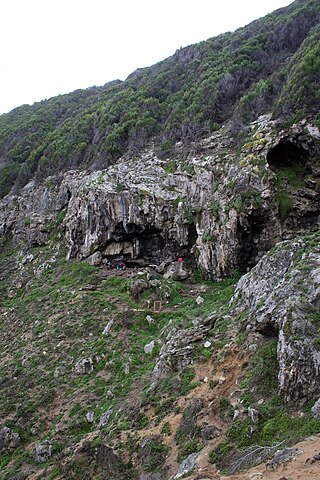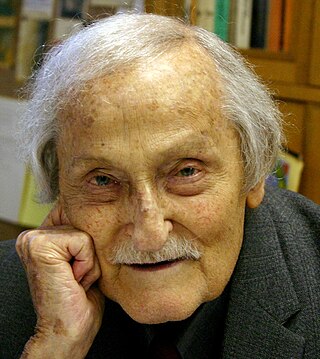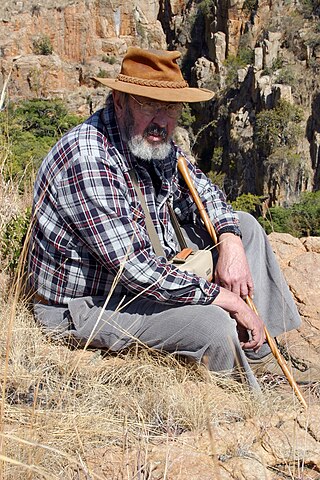Related Research Articles

The University of the Witwatersrand, Johannesburg, commonly known as Wits University or Wits, is a multi-campus public research university situated in the northern areas of central Johannesburg, South Africa. The university has its roots in the mining industry, as do Johannesburg and the Witwatersrand in general. Founded in 1896 as the South African School of Mines in Kimberley, it is the third oldest South African university in continuous operation.

Blombos Cave is an archaeological site located in Blombos Private Nature Reserve, about 300 km east of Cape Town on the Southern Cape coastline, South Africa. The cave contains Middle Stone Age (MSA) deposits currently dated at between c. 100,000 and 70,000 years Before Present (BP), and a Late Stone Age sequence dated at between 2000 and 300 years BP. The cave site was first excavated in 1991 and field work has been conducted there on a regular basis since 1997, and is ongoing.

Phillip Vallentine Tobias was a South African palaeoanthropologist and Professor Emeritus at the University of the Witwatersrand in Johannesburg. He was best known for his work at South Africa's hominid fossil sites. He was also an activist for the eradication of apartheid and gave numerous anti-apartheid speeches at protest rallies and also to academic audiences.
Henri Édouard Prosper Breuil, often referred to as Abbé Breuil, was a French Catholic priest, archaeologist, anthropologist, ethnologist and geologist. He is noted for his studies of cave art in the Somme and Dordogne valleys as well as in Spain, Portugal, Italy, Ireland, China with Teilhard de Chardin, Ethiopia, British Somali Coast Protectorate, and especially Southern Africa.

Charles Franklin Wandesforde Higham is a British-born New Zealand archaeologist most noted for his work in Southeast Asia. Among his noted contributions to archaeology are his work about the Angkor civilization in Cambodia, and his current work in Northeast Thailand. He is an emeritus professor at the University of Otago in Dunedin.

James William Kitching was a South African vertebrate palaeontologist and regarded as one of the world’s greatest fossil finders.

The Evolutionary Studies Institute (ESI) is a paleontological, paleoanthropological and archeological research institute operated through the Faculty of Science of the University of the Witwatersrand, Johannesburg, South Africa. Previously known as the Bernard Price Institute for Palaeontological Research (BPI) it was renamed the Evolutionary Studies Institute in 2013 to better showcase the scope of its research.
Charles Kimberlin Brain, also known as C. K. "Bob" Brain, was a South African paleontologist who studied and taught African cave taphonomy for more than fifty years.

Lee Rogers Berger is an American-born South African paleoanthropologist and National Geographic Explorer-in-Residence. He is best known for his discovery of the Australopithecus sediba type site, Malapa; his leadership of Rising Star Expedition in the excavation of Homo naledi at Rising Star Cave; and the Taung Bird of Prey Hypothesis.
Makapansgat is an archaeological location within the Makapansgat and Zwartkrans Valleys, northeast of Mokopane in Limpopo province, South Africa. It is an important palaeontological site, with the local limeworks containing Australopithecus-bearing deposits dating to between 3.0 and 2.6 million years BP. The whole Makapan Valley has been declared a South African Heritage Site. Makapansgat belongs to the Cradle of Humankind.
Thomas N. Huffman was Professor Emeritus of archaeology in association with the University of Witwatersrand in Johannesburg, South Africa. He specialised in pre-colonial farming societies in southern Africa. Huffman is most well known for his identification of the Central Cattle Pattern at Mapungubwe, a pre-colonial state in southern Africa. This, in turn he argued as the main influence in the formation of the Zimbabwe Pattern at Great Zimbabwe. Arguably his seminal contribution to the field was A Handbook to the Iron Age: The Archaeology of Pre-Colonial Farming Societies in Southern Africa (2007), which has contributed to the understanding of ceramic style analysis and culture history focusing on these groups.

Melville Koppies is a nature reserve and a Johannesburg City Heritage Site in Johannesburg, South Africa. The word 'koppie' means small hill.

Gondolin Cave is a fossiliferous dolomitic paleocave system in the Northwest Province, South Africa. The paleocave formed in the Eccles Formation dolomites. Gondolin is currently the only described hominin-bearing fossil site in the Northwest Province-portion of the designated Cradle of Humankind UNESCO World Heritage Site. The cave is located on privately owned land and is not accessible to the public. As is the case with other South African Paleo-cave systems with Pliocene and/or Pleistocene fossil deposits, the system was mined for lime during the early 20th century. As a result, the system has been heavily disturbed and consists of only a small active cave, a series of in situ remnant cave deposits, and extensive dumpsites of ex situ calcified sediments produced during mining activities.

André Werner Keyser, was a South African palaeontologist and geologist noted for his discovery of the Drimolen hominid site and of numerous hominid remains.

Hasmukh Dhirajlal Sankalia was an Indian Sanskrit scholar and archaeologist specialising in proto- and ancient Indian history. He is considered to have pioneered archaeological excavation techniques in India, with several significant discoveries from the prehistoric period to his credit. Sankalia received the Ranjitram Suvarna Chandrak award in 1966. And also received Padma Bhushan in the year 1974.
Lyn Wadley is an honorary professor of archaeology, and also affiliated jointly with the Archaeology Department and the Institute for Evolution at the University of the Witwatersrand in Johannesburg, South Africa.
Clarence van Riet Lowe was a South African civil engineer and archaeologist. He was appointed by Jan Smuts as the first director of the Bureau of Archaeology and was among the first group to investigate the archaeological site of Mapungubwe.

Kaditshwene aka Gaditshweni or Karechuenya, was a South African Iron Age settlement some 25 kilometres (16 mi) northeast of the town of Zeerust, North West province.
Bokoni was a pre-colonial, agro-pastoral society found in northwestern and southern parts of present-day Mpumalanga province, South Africa. Iconic to this area are stone-walled sites, found in a variety of shapes and forms. Bokoni sites also exhibit specialized farming and long-distance trading with other groups in surrounding regions. Bokoni saw occupation in varying forms between approximately 1500 and 1820 A.D.
Bolt's Farm is a palaeontological site in the Cradle of Humankind World Heritage Site, Gauteng province, South Africa. With more than 30 fossil deposits dating back 4.5 Ma, it is one of the oldest sites currently discovered in the Cradle of Humankind. It consists of multiple cavities, pits, and quarries, where caves have eroded away, exposing their fossiliferous interiors. Although this site has not yet yielded the hominid fossils for which the Cradle of Humankind is known, Bolt's Farm is still an important source of fossils from various species of Early Pliocene and Plio-Pleistocene fauna, including primates and big cats.
References
- 1 2 3 4 5 6 7 Mason, Petra. "Professor Revil John Mason 1929-2020". The Heritage Portal. Retrieved 24 August 2020.
- 1 2 Smillie, Shaun. "Revil Mason carried on excavating the past right until the end". Daily Maverick. Retrieved 25 August 2020.
- 1 2 3 4 5 Nkosi, Kgosi. "Golden Eagle Award: Professor Revil Mason". St John's College. Retrieved 15 July 2019.